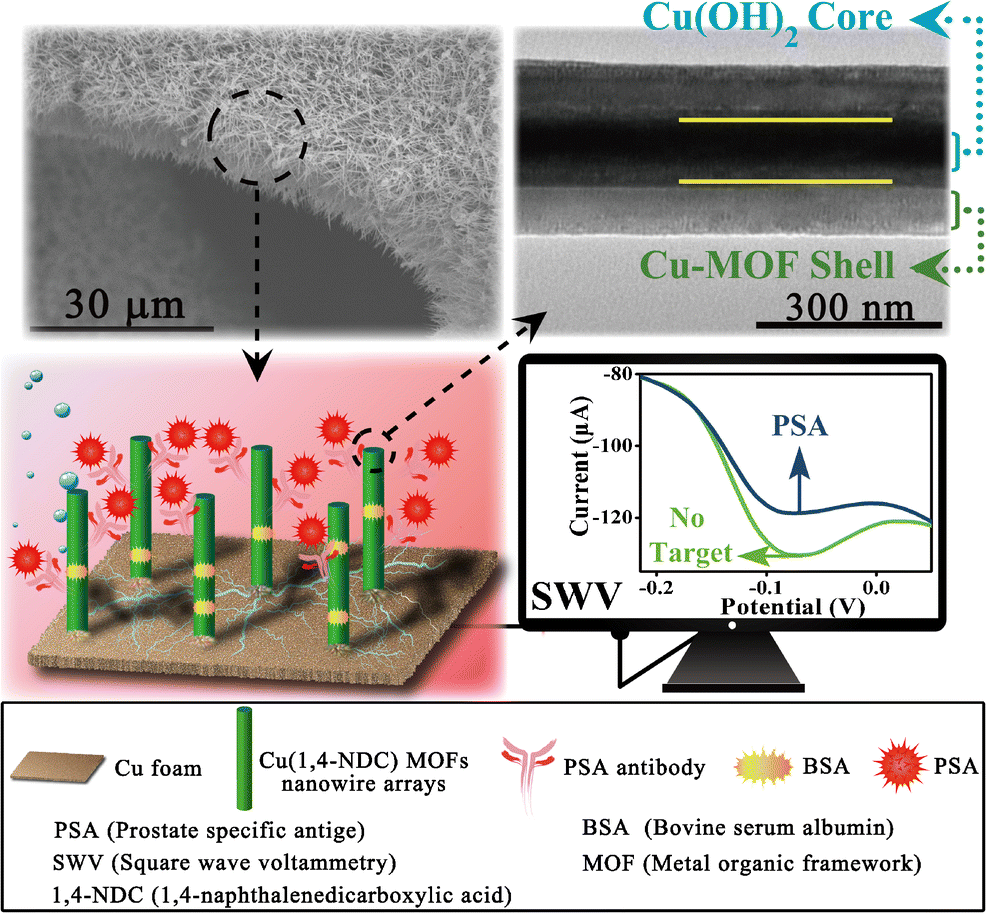当前位置:
X-MOL 学术
›
Microchim. Acta
›
论文详情
Our official English website, www.x-mol.net, welcomes your
feedback! (Note: you will need to create a separate account there.)
Copper(II) 1,4-naphthalenedicarboxylate on copper foam nanowire arrays for electrochemical immunosensing of the prostate specific antigen
Microchimica Acta ( IF 5.3 ) Pub Date : 2019-11-09 , DOI: 10.1007/s00604-019-3891-x Zi-Ang Chen 1 , Wenbo Lu 1 , Cancan Bao 1 , Qiangqiang Niu 1 , Xiaowei Cao 2 , Hui Wang 1 , Ru-Xin Yao 1
Microchimica Acta ( IF 5.3 ) Pub Date : 2019-11-09 , DOI: 10.1007/s00604-019-3891-x Zi-Ang Chen 1 , Wenbo Lu 1 , Cancan Bao 1 , Qiangqiang Niu 1 , Xiaowei Cao 2 , Hui Wang 1 , Ru-Xin Yao 1
Affiliation

|
Nanowires of copper(II)-based metal-organic frameworks (Cu-MOFs) of type Cu(II)(1,4-naphthalenedicarboxylic acid) (1,4-NDC) were deposited on the surface of a copper foam by immersion of Cu(OH)2 nanowires in a solution of 1,4-NDC. An electrochemical immunosensor for the prostate specific antigen (PSA) is obtained by using the nanowire arrays as a redox signal probe. The signal is generated by the conversion of Cu(I) and Cu(II) of Cu-MOFs nanowires. Cu(1,4-NDC) nanowires contain many uncoordinated carboxyl groups which can bind to the amino groups of the PSA antibody. When PSA antibody binds to PSA antigen during an immune response, the current signal will decrease due to the electrical insulation of PSA antigen. The decrease of current is directly proportional to the increase of PSA concentration. The immunosensor, best operated at a voltage of typically −0.08 V (vs. Ag/AgCl), has a low limit of detection (4.4 fg·mL−1) and a wide linear range (0.1 pg·mL−1 to 20 ng·mL−1). This meets the demands of clinical diagnosis (with values <4 ng·mL−1) in serum. The method was applied to the determination of PSA in spiked serum. Graphical abstract Schematic representation of the in-situ growth of ordered Cu-MOFs wrapped with Cu(OH)2 nanowires, building the core-shell structure as the 3D electrode. A novel electrochemical immunosensor for PSA detection has been exploited, using the Cu-MOFs nanowire arrays on Cu foam as a redox signal probe for the first time. Schematic representation of the in-situ growth of ordered Cu-MOFs wrapped with Cu(OH)2 nanowires, building the core-shell structure as the 3D electrode. A novel electrochemical immunosensor for PSA detection has been exploited, using the Cu-MOFs nanowire arrays on Cu foam as a redox signal probe for the first time.
中文翻译:

铜泡沫纳米线阵列上的 1,4-萘二甲酸铜 (II) 用于前列腺特异性抗原的电化学免疫传感
Cu(II)(1,4-萘二甲酸) (1,4-NDC) 型铜 (II) 基金属有机骨架 (Cu-MOFs) 纳米线通过浸入铜泡沫表面沉积Cu(OH)2 纳米线在 1,4-NDC 溶液中。通过使用纳米线阵列作为氧化还原信号探针,获得了前列腺特异性抗原 (PSA) 的电化学免疫传感器。该信号是由 Cu-MOFs 纳米线的 Cu(I) 和 Cu(II) 的转换产生的。Cu(1,4-NDC) 纳米线包含许多未配位的羧基,可以与 PSA 抗体的氨基结合。当 PSA 抗体在免疫反应过程中与 PSA 抗原结合时,由于 PSA 抗原的电绝缘性,电流信号会降低。电流的减少与PSA浓度的增加成正比。免疫传感器,最佳工作电压通常为 -0.08 V(相对于 Ag/AgCl),具有低检测限 (4.4 fg·mL-1) 和宽线性范围(0.1 pg·mL-1 至 20 ng·mL-) 1)。这满足血清中临床诊断的要求(值<4 ng·mL-1)。该方法用于测定加标血清中的PSA。图形摘要 用 Cu(OH)2 纳米线包裹的有序 Cu-MOF 的原位生长示意图,构建核壳结构作为 3D 电极。已经开发了一种用于PSA检测的新型电化学免疫传感器,首次使用Cu泡沫上的Cu-MOFs纳米线阵列作为氧化还原信号探针。用 Cu(OH)2 纳米线包裹有序 Cu-MOF 的原位生长示意图,构建核壳结构作为 3D 电极。
更新日期:2019-11-09
中文翻译:

铜泡沫纳米线阵列上的 1,4-萘二甲酸铜 (II) 用于前列腺特异性抗原的电化学免疫传感
Cu(II)(1,4-萘二甲酸) (1,4-NDC) 型铜 (II) 基金属有机骨架 (Cu-MOFs) 纳米线通过浸入铜泡沫表面沉积Cu(OH)2 纳米线在 1,4-NDC 溶液中。通过使用纳米线阵列作为氧化还原信号探针,获得了前列腺特异性抗原 (PSA) 的电化学免疫传感器。该信号是由 Cu-MOFs 纳米线的 Cu(I) 和 Cu(II) 的转换产生的。Cu(1,4-NDC) 纳米线包含许多未配位的羧基,可以与 PSA 抗体的氨基结合。当 PSA 抗体在免疫反应过程中与 PSA 抗原结合时,由于 PSA 抗原的电绝缘性,电流信号会降低。电流的减少与PSA浓度的增加成正比。免疫传感器,最佳工作电压通常为 -0.08 V(相对于 Ag/AgCl),具有低检测限 (4.4 fg·mL-1) 和宽线性范围(0.1 pg·mL-1 至 20 ng·mL-) 1)。这满足血清中临床诊断的要求(值<4 ng·mL-1)。该方法用于测定加标血清中的PSA。图形摘要 用 Cu(OH)2 纳米线包裹的有序 Cu-MOF 的原位生长示意图,构建核壳结构作为 3D 电极。已经开发了一种用于PSA检测的新型电化学免疫传感器,首次使用Cu泡沫上的Cu-MOFs纳米线阵列作为氧化还原信号探针。用 Cu(OH)2 纳米线包裹有序 Cu-MOF 的原位生长示意图,构建核壳结构作为 3D 电极。





















































 京公网安备 11010802027423号
京公网安备 11010802027423号